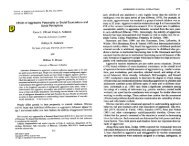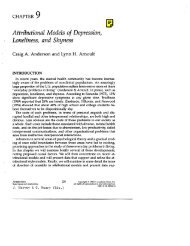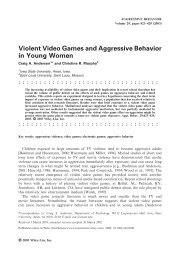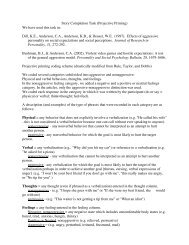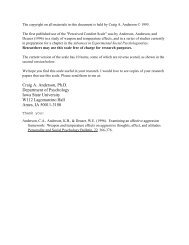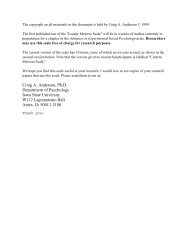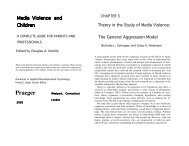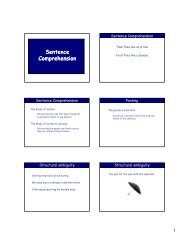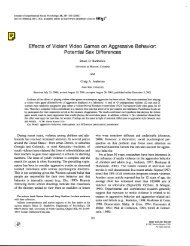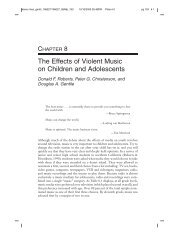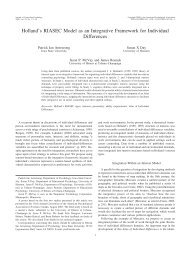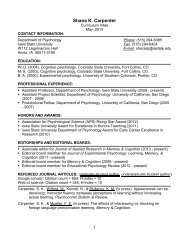Measures of attributional style
Measures of attributional style
Measures of attributional style
You also want an ePaper? Increase the reach of your titles
YUMPU automatically turns print PDFs into web optimized ePapers that Google loves.
Attribution Styles 119<br />
explanation along the dimensions <strong>of</strong> internal<br />
locus, external locus, stability, controllability,<br />
globality, and intentionality. The internal consistency<br />
for the scale is moderate to good.<br />
Relationships<br />
Several different types <strong>of</strong> intermediate <strong>attributional</strong><br />
<strong>style</strong> measures have been developed for<br />
measuring attributions in the context <strong>of</strong> relationships.<br />
The Relationship Attribution Measure<br />
(RAM; Bradbury & Fincham, 1990) assesses<br />
the types <strong>of</strong> attributions people make for a<br />
spouse’s negative behaviour. Respondents read a<br />
hypothetical negative action by their partner and<br />
rate the causes <strong>of</strong> that event along six dimensions:<br />
locus, stability, globality, and responsibility<br />
(intent, selfishness, and blame). Researchers can<br />
use either a four- or eight- item version. A<br />
composite <strong>of</strong> all <strong>attributional</strong> dimensions displays<br />
high internal consistency and predicts marital<br />
satisfaction. Partners who attribute negative<br />
partner behaviour to internal, stable, and global<br />
causes are more likely to be dissatisfied with the<br />
relationship. Fincham has also developed a<br />
version <strong>of</strong> the RAM for use with children to<br />
assess attributions for parent–child interactions.<br />
The Children’s Relationship Attribution Measure<br />
(CRAM; Fincham, Beach, Arias, & Brody, 1998)<br />
uses a format similar to the RAM, and contains<br />
descriptions <strong>of</strong> two negative events.<br />
CONCLUSIONS<br />
Future Research<br />
<strong>Measures</strong> <strong>of</strong> <strong>attributional</strong> <strong>style</strong> have generated<br />
several issues which require additional research.<br />
The first issue involves level <strong>of</strong> specificity. Many<br />
studies question the presence <strong>of</strong> a global<br />
<strong>attributional</strong> <strong>style</strong>, and it is not clear if<br />
intermediate measures provide a satisfying solution<br />
to this problem. Additional research is<br />
needed to resolve these issues. Furthermore,<br />
<strong>attributional</strong> <strong>style</strong> measures typically suffer from<br />
poor reliability. New measures need to be<br />
developed to address this shortcoming. Finally,<br />
more research is needed on the controllability<br />
dimension <strong>of</strong> <strong>attributional</strong> <strong>style</strong> and on the<br />
unique contributions <strong>of</strong> the various <strong>attributional</strong><br />
dimensions.<br />
Using Attributional Style <strong>Measures</strong><br />
There are numerous ways <strong>of</strong> measuring <strong>attributional</strong><br />
<strong>style</strong>, each with particular strengths and<br />
weaknesses. In deciding which scale to use, the<br />
researcher needs to carefully consider the specific<br />
goals <strong>of</strong> the research project, and then pick the<br />
tool that best meets the needs <strong>of</strong> that project. The<br />
modest reliabilities <strong>of</strong> these scales suggests that<br />
considerable attention be paid to sample size and<br />
power.<br />
Notes<br />
1 The various ASAT scales, as well as Chinese<br />
versions <strong>of</strong> that ASAT-I, the Beck Depression<br />
Inventory, and the Revised UCLA loneliness<br />
scales, can be downloaded from the following<br />
web site: psych-server.iastate.edu/faculty/caa/<br />
Scales/Scales.html<br />
References<br />
Abramson, L.Y., Seligman, M.E.P. & Teasdale, J.<br />
(1978). Learned helplessness in humans: Critique<br />
and reformulation. Journal <strong>of</strong> Abnormal Psychology,<br />
87, 49–74.<br />
Anderson, C.A. (1999). Attributional <strong>style</strong>, depression,<br />
and loneliness: a cross-cultural comparison <strong>of</strong><br />
American and Chinese students. Personality and<br />
Social Psychology Bulletin, 25, 482–499.<br />
Anderson, C.A., & Riger, A.L. (1991). A controllability<br />
<strong>attributional</strong> model <strong>of</strong> problems in living:<br />
dimensional and situational interactions in the<br />
prediction <strong>of</strong> depression and loneliness. Social<br />
Cognition, 9, 149–181.<br />
Bradbury, T.N., & Fincham, F.D. (1990). Attributions<br />
in marriage: review and critique. Psychological<br />
Bulletin, 107, 3–33.<br />
Burns, M.O. & Seligman, M.E.P. (1989). Explanatory<br />
<strong>style</strong> across the life span: evidence for stability over<br />
52 years. Journal <strong>of</strong> Personality and Social<br />
Psychology, 56, 471–477.<br />
Carver, C.S. (1989). How should multifaceted personality<br />
constructs be tested? Issues illustrated by selfmonitoring,<br />
<strong>attributional</strong> <strong>style</strong>, and hardiness.<br />
Journal <strong>of</strong> Personality and Social Psychology, 56,<br />
577–585.<br />
Cutrona, C.E., Russell, D. & Jones, R.D. (1985).<br />
Cross-situational consistency in causal attributions:<br />
does <strong>attributional</strong> <strong>style</strong> exist? Journal <strong>of</strong><br />
Personality and Social Psychology, 47,<br />
1043–1058.<br />
Deuser, W.E. & Anderson, C.A. (1995). Controllability<br />
attributions and learned helplessness: some methodological<br />
and conceptual problems. Basic and<br />
Applied Social Psychology, 16, 297–318.<br />
[8.8.2002–12:29pm] [1–128] [Page No. 119] FIRST PROOFS {Books}Ballesteros/Ballesteros-A.3d Paper: Ballesteros-A Keyword



